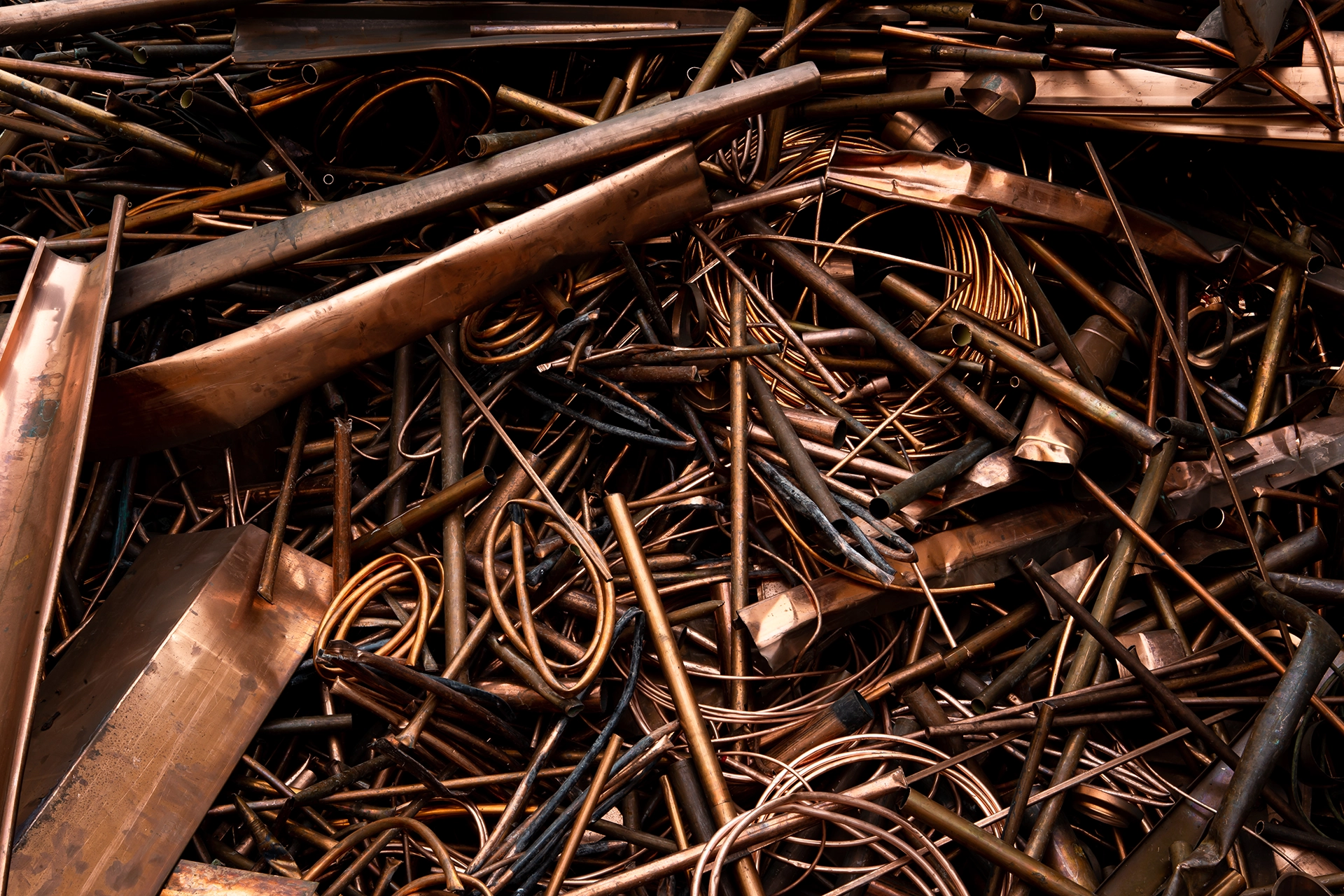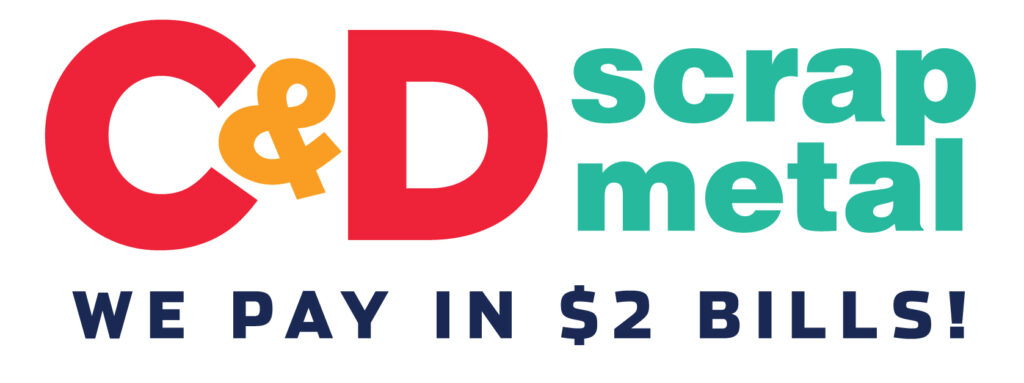Understanding Red Metals – A Scrapper’s Guide to Copper, Brass and Bronze

If you’re new to scrapping, you’ve probably heard the term “red metals” thrown around. But what exactly are they, and why do they matter? Simple: red metals—copper, brass, and bronze—are some of the most valuable scrap materials you can get your hands on. If you know what to look for and how to prep them right, you can turn scrap into serious cash at C&D Scrap Metal. Let’s break it down!
What Are Red Metals?
Red metals are known for their reddish hue and excellent conductivity. You can find copper, brass and bronze everywhere—in old plumbing, electrical wiring, and even decorative household items. If you’re tossing them in with your general scrap pile, you’re leaving money on the table. When looking for scrap copper prices and brass scrap prices, knowing what red metals are worth can make a big difference.
Understanding the Cost and Value of Copper, Brass, and Bronze
Copper – The Money Maker
Copper is king in the scrap world. It’s pure, in high demand, and pays out the most. Here’s how to recognize and sort it:
- Bare Bright Copper – The gold standard. Stripped of insulation, bright, and clean. Highest payout, so always aim for the best copper scrap price.
- #1 Copper – Clean, uncoated, and free of solder or paint. Worth a lot, but not quite as much as bare bright.
- #2 Copper – Has some oxidation, solder, or light coatings. Still valuable, but lower grade.
Brass – The Heavy Hitter
Brass is a mix of copper and zinc. It’s common and still pays well. Look for:
- Yellow Brass – Found in plumbing fixtures and some decorative pieces.
- Red Brass – Contains more copper, making it worth more than yellow brass.
- Cartridge Brass, or brass shell casings – A common material for bullet casings, electrical components, and various industrial parts. Usually clean and high-quality.
Bronze – The Tough One
Bronze is a mix of copper and tin, used in industrial settings, statues, and boat fittings. It’s darker than brass and sometimes has a greenish patina. Not as common but still valuable, especially in non-ferrous metal recycling.
How to Identify Red Metals
- Copper: Reddish-brown, soft, and develops a green patina over time.
- Brass: More yellowish, heavier than copper, and non-magnetic.
- Bronze: Darker than brass, often with a reddish-brown or greenish tint.
Rookie Tip: Use a magnet test. If it sticks, it’s got iron in it—not a true red metal!
Best Practices for Scrapping Copper, Brass, and Bronze
Want top dollar for your scrap? Follow these steps:
- Sort Where You Can– While keeping different grades of copper separate can maximize value, sorting isn’t always possible. For example, plumbing fixtures often contain multiple types of metals. While they can be cut into separate chunks, it’s not required—separate and sort when it makes sense.
- Strip Wiring (If You Can) – Insulated wire sells for less than clean bare bright copper. If you have the right tools, like a reciprocating saw or a wire stripper, you can separate non-copper fittings to get more value. Not everyone can strip their wiring, and some try to burn off the insulation—but this is a no-go, as it reduces the copper’s value.
- Remove Contaminants – Solder, coatings, and other impurities lower your payout. This applies to plumbing fixtures as well.
Where to Find Red Metals
Red metals are all around you in everyday products. Here’s where you can find them:
- Appliances (Fridges, Air Conditioners, Washing Machines – internal wiring and motors)
- Copper: Found in internal wiring, motors, and compressor coils.
- Brass: Often used in valves, fittings, and connectors.
- Bronze: Rare, but sometimes used in parts of motors or fittings.
- Electronics (Power Cords and Circuit Boards)
- Copper: Found in wiring, power cords, and internal circuit boards.
- Brass: Used in connectors, plugs, and some components.
- Bronze: May appear in connectors and electrical parts, though less common.
- Plumbing (Pipes, Valves, and Fittings)
- Copper: Commonly used in water pipes and plumbing fittings.
- Brass: Used for valves, faucets, and fittings.
- Bronze: Sometimes used for durable fittings and valves, especially in marine-grade plumbing.
- Automobiles (Radiators, Alternators, and Wiring Harnesses)
- Copper: Found in wiring, alternators, radiators, and some electrical components.
- Brass: Often used in radiator fittings, connectors, and some parts of the cooling system.
- Bronze: Rare, but may be used in bearings or specific engine components.
Want to learn how to scrap your car the right way? C&D can help! Get the most value from your vehicle with expert guidance.
- Construction Materials (Roofing Sheets, Gutters, and Electrical Wiring)
- Copper: Common in electrical wiring, gutters, and roofing (copper roofing).
- Brass: Used in electrical connectors and certain fittings.
- Bronze: Less common but may be found in some fasteners or fittings.
- Household Items (Lamps, Decorative Fixtures, and Brass Doorknobs)
- Copper: Found in electrical components, wiring, and some decorative items.
- Brass: Very common in decorative fixtures, doorknobs, and lamp bases.
- Bronze: Sometimes used in decorative fixtures and hardware.
FAQs
1. Should I strip wires for copper scrap?
Yes—if you have the right tools and the time, stripping wires can increase your payout, but only when it’s done the right way. Bare bright copper sells for significantly more than insulated wire. However, burning the insulation is NOT recommended—this damages the copper and reduces its value, meaning you won’t get the best price for your scrap.
2. What’s the best way to clean red metals before selling?
Use a wire brush or sandpaper to remove oxidation, and get rid of coatings, solder, or any non-metal attachments.
3. How much can I make scrapping red metals?
It depends on the market, but copper is always a top-dollar item. Red metals bring in more than heavier metals like steel. Ever wondered why scrap metal prices fluctuate?
Here’s a quick breakdown of what determines the copper, brass and bronze scrap prices:
- Type and Quality: The cleaner and purer your metal, the more it’s worth. Think of it as the VIP treatment—quality matters!
- Market Demand: Scrap prices move with the market. If demand for red metals is high, your payout goes up too.
- Quantity: The more metal you bring in, the better your rate. Bigger hauls often mean better deals.
- Processing Costs: Sorting, cleaning, and transporting scrap take time and resources. While you get paid, processing costs also play into the final price.
Maximize Your Copper, Brass, and Bronze, Maximize Your Cash
Scrapping red metals isn’t just about tossing some pipes and wires in a bin—it’s about knowing what you have and making the most of it. By identifying, sorting, and prepping your copper, brass, and bronze, you can turn scrap into serious profit. Whether you’re looking for red metals recycling or want to cash in on scrap non-ferrous metals, bring your materials to a red metal scrap yard like C&D for top-dollar payouts and hassle-free recycling. We’re ready to receive your red metals today!
